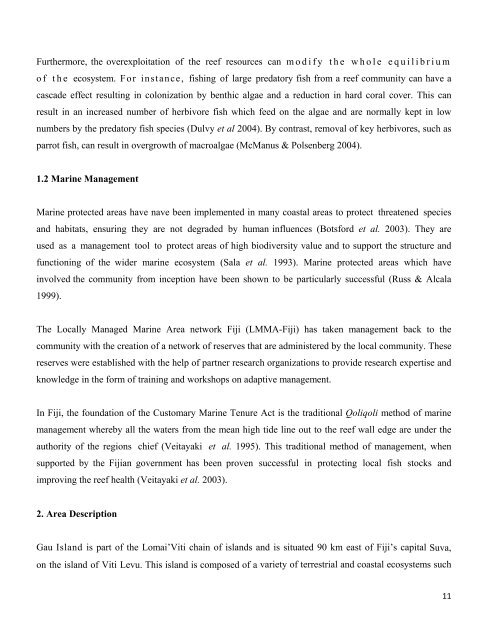Frontier Fiji Marine Environmental Research - Frontier-publications ...
Frontier Fiji Marine Environmental Research - Frontier-publications ...
Frontier Fiji Marine Environmental Research - Frontier-publications ...
Create successful ePaper yourself
Turn your PDF publications into a flip-book with our unique Google optimized e-Paper software.
Furthermore, the overexploitation of the reef resources can modify the whole equilibrium<br />
o f t h e ecosystem. For instance, fishing of large predatory fish from a reef community can have a<br />
cascade effect resulting in colonization by benthic algae and a reduction in hard coral cover. This can<br />
result in an increased number of herbivore fish which feed on the algae and are normally kept in low<br />
numbers by the predatory fish species (Dulvy et al 2004). By contrast, removal of key herbivores, such as<br />
parrot fish, can result in overgrowth of macroalgae (McManus & Polsenberg 2004).<br />
1.2 <strong>Marine</strong> Management<br />
<strong>Marine</strong> protected areas have nave been implemented in many coastal areas to protect threatened species<br />
and habitats, ensuring they are not degraded by human influences (Botsford et al. 2003). They are<br />
used as a management tool to protect areas of high biodiversity value and to support the structure and<br />
functioning of the wider marine ecosystem (Sala et al. 1993). <strong>Marine</strong> protected areas which have<br />
involved the community from inception have been shown to be particularly successful (Russ & Alcala<br />
1999).<br />
The Locally Managed <strong>Marine</strong> Area network <strong>Fiji</strong> (LMMA-<strong>Fiji</strong>) has taken management back to the<br />
community with the creation of a network of reserves that are administered by the local community. These<br />
reserves were established with the help of partner research organizations to provide research expertise and<br />
knowledge in the form of training and workshops on adaptive management.<br />
In <strong>Fiji</strong>, the foundation of the Customary <strong>Marine</strong> Tenure Act is the traditional Qoliqoli method of marine<br />
management whereby all the waters from the mean high tide line out to the reef wall edge are under the<br />
authority of the regions chief (Veitayaki et al. 1995). This traditional method of management, when<br />
supported by the <strong>Fiji</strong>an government has been proven successful in protecting local fish stocks and<br />
improving the reef health (Veitayaki et al. 2003).<br />
2. Area Description<br />
Gau Island is part of the Lomai’Viti chain of islands and is situated 90 km east of <strong>Fiji</strong>’s capital Suva,<br />
on the island of Viti Levu. This island is composed of a variety of terrestrial and coastal ecosystems such<br />
11
















